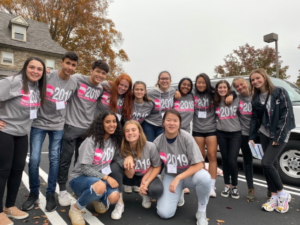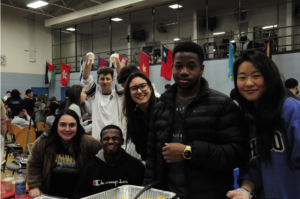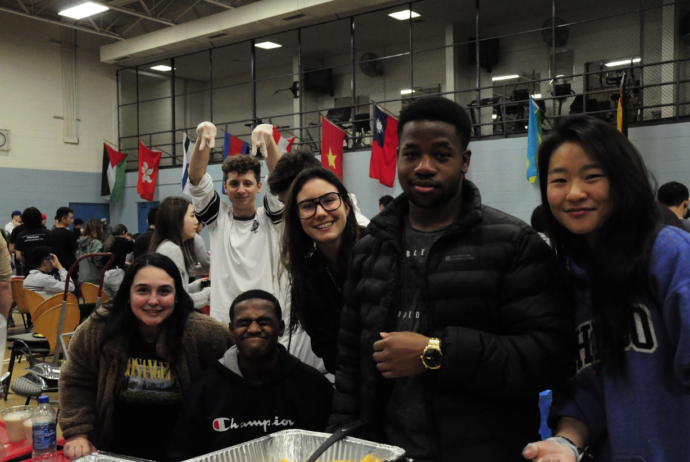
Sem students attend the MARD Conference (Photo Courtesy of Wyoming Seminary)
By Kate Getz ’21
On October 26, 2019, 14 Sem students and two faculty members traveled to Abington Friends School in Jenkintown, Pennsylvania, for the Annual Mid-Atlantic Regional Diversity Conference (MARD). As one of the students who had the opportunity to attend this conference, I thought I would share my personal experience at MARD.
Walking into this conference, I wasn’t sure what to expect. I had been to a diversity conference with Sem before, but this was my first time at MARD. The conference began with what was probably my favorite part of the meeting, the speaker Dr. Rodney Glasgow. Among his long list of accomplishments and accreditations, Dr. Glasgow is a Harvard graduate in Afro-American Studies and Psychology and is currently the Head of Middle School and Chief Diversity Officer at St. Andrew’s Episcopal School in Potomac, Maryland. Many of his other accreditations revolve around social action, diversity, and justice.
As many of my fellow U.S. History students may know, the year 2019 marks 400 years since the first slaves landed in Jamestown, VA. Even though slavery was illegal in the United States after the Civil War, our society, as Dr. Glasgow demonstrated, contains remnants of the slave society we once had, especially in independent schools. His significant examples of the similarities between 1619 and 2019 included the suppression of language and hair as well as unfair punishments targeting specific students. The most remarkable part was how his demonstration of the unfair power dynamics within independent schools resonated with so many of the students and faculty listening.
After some students concluded his speech by sharing their own experiences with what he called “2019 in a 1619 Mindset”, we transitioned into an activity called “The Silent Movement.” In this activity, everyone gathers in a large circle around the gym. Dr. Glasgow would say a statement, and if you identified with that statement, you made your way into the center of the ring to form a smaller circle. Then, you would observe those accompanying you in the circle and those outside the circle. All of this was in complete silence beside the sound of footsteps moving about the gym. As we explored the topics of race, religion, sexual identity, gender identity, and more, I was shocked at how quickly and confidently people moved when they came across a statement they identified with. With each statement, I had to take a second to consider how I identified in relation to the topic. Regardless, it was a meaningful and educational activity that taught me that it’s okay to be a bit unsure about any part of your identity. Later, conversations with my friends showed that I was not the only one who felt uncertain at specific points.
From the speech, we moved into home-groups, which were comprised of about twelve students from a variety of schools and backgrounds. Here, we did an activity meant to facilitate conversations about identifying with the majority or minority. If you identified as the minority for a topic, which was similar to some of those in the “Silent Movement,” you made your way to the center of the circle to discuss what you want the majority to know. This activity was meant to drive conversation and not just understanding about identity like the “Silent Movement.” As someone who identified with the majority for most of the topics, I felt that it was very educational to listen to the conversation rather than contributing myself. I would say that I learned more here than I did in any other discussion-based activities.
After these groups, we all had the opportunity to go to two different student-run workshops about a variety of topics. The first one I went to was called “Mental Illness in the Media,” where we discussed how social media impacts the mental health of teenagers. We also got into conversation about how mental illness is portrayed in other forms of media, such as TV and movies. The second workshop I went to was called “Leveling the Playing Field: Women and Sports,” where we were given a presentation on some frankly terrifying statistics on the discrimination and inequality of women in sports as players, coaches, and trainers.
Following the workshops, everyone went to an affinity group, which could be defined as “a group with a common interest or goal.” In this specific context, they also serve as a space for people to discuss common issues they face in a safe space. I ended up in the “White Allies” group. I was very worried that this group was going to be an extremely uncomfortable and awkward experience, and it absolutely was, but in the best way possible. In this group, we did what is called an “Agree/Disagree Challenge,” where you are given a statement, and then you place yourself on a spectrum according to how much you agree. The comments started as funny and simple, but they developed into deep, thoughtful questions about our position in a racist system and society from which we benefit. After each statement, we had the opportunity to discuss our position and even move our placement in the spectrum. While I undeniably felt uncomfortable at some points in this group, I never felt unsafe, which I realized is a benefit I receive every day simply because of my race.
After a long but meaningful hour and a half, the conference had ended; however, the lessons and conversations I had during it changed my thinking about the idea of identity. I learned to be considerate and conscientious of not only how other people around me identify but also how I identify myself. I came into MARD already understanding how necessary change is in growth, but this entire conference reaffirmed it all over again. So, my final message for everyone who did not attend the conference is that it is okay to be pursuing growth and change in your identity regardless of what point of your life you are at. Also, if anything in this article interested you, I sincerely encourage you to consider coming to the next diversity conference that Sem attends.
I also asked Dorothea Schorling ’22 and Jillayne Gumbs ’20, one of the SOCA (Students of Color Association) leaders, to share their own experiences at MARD.
Dea:
What was the most significant part of the speaker’s presentation for you?
The speech of the speaker was generally very appealing, even if it was a topic that you haven’t experienced by yourself. So for me, the most significant part was the active part when he asked all of us to sort into social categories in topics families, race, gender, sexual orientation, and so on. The feeling of understanding, not judging an honesty was something very special.
What message from the conference would you like to share with everyone who did not attend? That everybody is different from each other, with differences in all kinds of areas, but we all just want to feel accepted, having the same rights, and being treated like that as well.
Which one of your workshops was your favorite? What did you learn or gain from it? My favorite workshop was mental diseases in social media and movies. Many students in my group had their own experience of mental diseases and were, therefore, able to speak about that topic with a different view. I gained a lot of this conversation, but one thing we all have to know how to change it in our community is that the wrong explanation of diseases in every area of media and the abuse by naming this mental diseases in the wrong way and resulting from it self-diagnosis makes it very hard for people with a “real “diagnosis to see that they have this disease. They also struggle with being able to talk about their mental illness because of the abuse in social media. They fear that people will not take it seriously and getting comments and judgments of people who are “educated “by false sources.
What lessons did you learn or gain from attending the conference? I learned that there are so many definitions for different situations and self-knowledge, but that the important part is not to know all definitions, rather have the acceptance and openness for every human-like he is and how he feels.
What was your favorite part of the day, and why? My favorite part was the group talk because the diversity of cultures, living- and body situations was very exciting. To hear all the different stories of the people and seeing the differences but also the similarities were very instructive.
What were you expecting coming into this conference since it was your first one? Do you think you will attend any more conferences? I have never been to a conference like that before, and I would definitely go again if I get the chance to. Since it was my first one, I had no clue what to expect I just knew it was about diversity, but what I gained from this day definitely exceeded my “expectations” by miles (if I can say that).
Jillayne:
What was the most significant part of the speaker’s presentation for you? For me, the most impactful part of the speech was that I could feel that everyone was able to resonate with it in different ways. I know, personally, almost everything Dr. Glasgow said was something that I had been struggling with since I started going to independent, private schools in the 5th grade. When he would mention having to change my hair or always being the spokesperson for people of color, it was something that I didn’t think about often. The best part of his speech was when he would ask the audience to raise their hands if they felt the same way, and it was comforting to see that other people could relate, regardless of their background.
What message from the conference would you like to share with everyone who did not attend? The message I would share is to be mindful of others and strive to understand people’s differences. It’s easy to categorize people into different labels and use that to define them. Even though it’s cliche, everyone truly is unique and comes from different perspectives and backgrounds. Something that’s important is understanding that so many people identify differently, and sometimes those things can be hidden. But, it’s worth it to try to learn from and relate to others, so that we encourage a safer community both in and out of SEM.
Which one of your workshops was your favorite? What did you learn or gain from it? My favorite workshop was Appropriation vs. Appreciation. It was nice to have a conversation with a group of open-minded people so that we could all learn more about the topic. We had a diverse group, all with different opinions on the subject, but it gave us all a better outlook on the topic. I learned more about the importance of various cultural aspects, and my group was able to define the difference between cultural appropriation and appreciation more clearly.
What did you learn or gain from attending the conference? How was it different from other conferences you have attended? This is my second time going to MARD, and I always get something new out of it when I go. The workshops and affinity groups I went to gave the other SOCA leaders and me a lot of ideas for discussion and activities that we hope to implement in our meetings. From activities like Silent Movement, I was able to feel more comfortable and secure in my identity, and I hope that SOCA can help bring that to the student body at SEM.
What was your favorite part of the day, and why? My favorite part of the day was going to the LGBTQ+ affinity group because the energy in the room was so high. I felt that everyone at the conference was excited to be there, but a lot of the students in the LGBTQ+ group were so hyped, and it felt like a family as soon as we walked in. It was nice to see all of the students, especially those who don’t have LGBTQ+ groups at their own schools, feel a place where they were comfortable and accepted.
Do you have any information about SOCA that you would like to share? SOCA recognizes that diversity is not only about color, but everything that makes you unique. We strive to have meetings where people feel free to discuss topics surrounding identity, whether that’s religion, race, culture, sexual orientation, or gender. We’d love to have everyone come to the meetings if they can!


